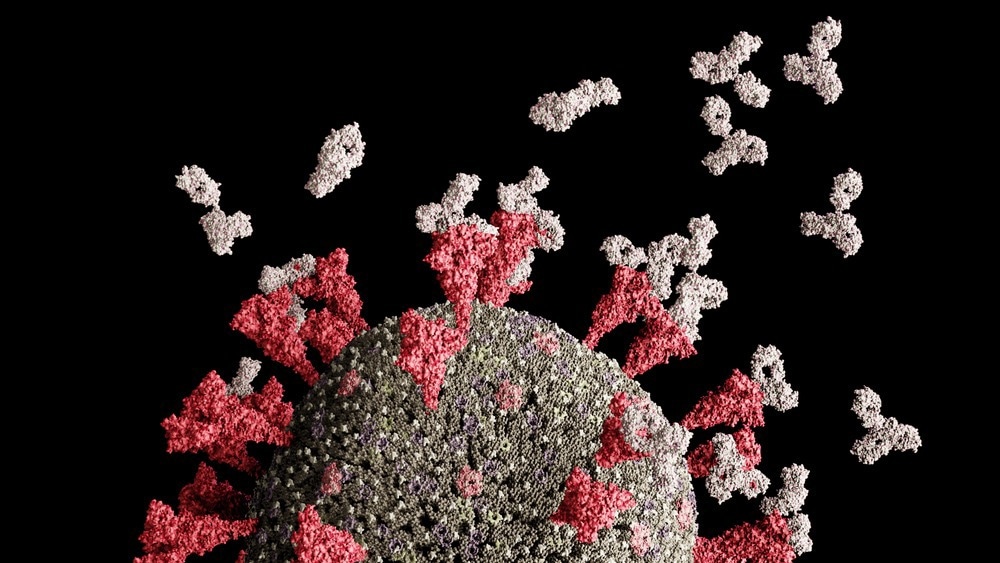Severe acute respiratory syndrome coronavirus 2 (SARS-CoV-2) is the cause behind the ongoing COVID-19 pandemic, infecting millions across the globe. Early diagnosis and management of SARS-CoV-2 are crucial for traceability, timely treatment, and prevention of viral spread.

Study: Graphene-Based Field-Effect Transistor for Ultrasensitive Immunosensing of SARS-CoV-2 Spike S1 Antigen. Image Credit: Leonid Altman/Shutterstock.com
In an article recently published in the journal ACS Applied Biomaterials, the researchers discussed a novel rapid method to detect SARS-CoV-2 spike S1 antigen (S1-Ag) with high sensitivity using a graphene-based field-effect transistor (FET).
The in-house developed anti-spike S1 antibody (S1-Ab) was immobilized covalently on the graphene. Moreover, the graphene was surface-functionalized with carboxyl groups via carbodiimide chemistry.
Ultraviolet-visible (UV-vis) spectroscopy, Fourier-transform infrared (FTIR) spectroscopy, atomic force microscopy (AFM), X-ray photoelectron spectroscopy (XPS), scanning electron microscopy (SEM), Raman spectroscopy, optical microscopy, enzyme-linked immunosorbent assays (ELISA) helped characterize the fabrication and bioconjugation process of graphene-based FET.
The electrical response of the device was correlated to the change in resistance caused because of real-time interaction between Ag–Ab. The graphene-based-FET devices tested for S1-Ag, in the range of 1-femtomolar to 1-micromolar revealed that the developed graphene-based-FET devices were highly specific and sensitive to even low levels of S1-Ag
SARS-CoV-2 Detection Techniques
The structural components of the SARS-CoV-2 virus constitute a single-stranded (ss) RNA, nucleocapsid (Nuc), spike (S), matrix (M), and envelope (E). SARS-CoV-2 has genomic similarity with bat coronavirus, RaTG13, and Middle East respiratory syndrome (MERS-CoV). SARS-CoV-2 enters the host cell through angiotensin-converting enzyme II (ACE2), present in mammalian cells.
Reverse-transcriptase polymerase chain reaction (RT-PCR), lateral flow-based chromatographic strip, and chest computed tomography (CT) are the main diagnostic techniques for SARS-CoV-2 detection. However, RT-PCR and CT scans are expensive and time-delayed techniques that require skilled professionals for operation. Moreover, viral detection via CT scan is non-specific to virus strain and requires a high radiation dose. Hence, a robust and sensitive diagnostic technique is required for viral Ag rapid detection.
Fluorine doped tin oxide (FTO)-based immunosensor is a SARS-CoV-2 detector with a limit of detection (LOD) of 0.73 femtomoles. Biomolecules like enzymes, antibodies, aptamers, and nucleic acid are used to detect target molecules. However, antibodies are better biorecognition elements over other DNA and aptamers due to their high stability, high affinity, and immobilization on various sensing elements like graphene.
Several nanomaterials such as iron oxide nanoparticles (NPs), gold (Au) NPs, organogels, carbon nanotubes, and graphene enhance the biosensor’s sensitivity. Graphene is a hexagonal two-dimensional (2D) material that is preferable compared to nanomaterials in designing sensitive biosensors. Moreover, graphene-based FETs have great potential for the development of diagnostic platforms. Although several FET-based sensors were previously reported for SARS-CoV-2 detection, they had sophisticated fabrication requirements.
Graphene-based-FET for Immunosensing of SARS-CoV‑2 S1-Ab
In the present study, the researchers generated an in-house S1-Ab modified graphene and developed a CoV-sensing FET device to detect SARS-CoV-2 S1-Ab. The in-house generated S1-Abs in the present study made the sensor fabrication a cost-effective method. Fabrication of graphene-based FETs was via silica (SiO2)/silicon (Si) substrate-based conventional Scotch-tape exfoliation process, followed by electron beam lithography (EBL) and metallization with a 5/50 nanometers ratio of chromium (Cr)/Au, respectively.
The in-house generated S1-Ab were conjugated covalently with graphene via carbodiimide chemistry. S1-Ab interaction with graphene-conjugated S1-Ab resulted in the local doping redistribution and consequently changed graphene’s resistance which is monitored. The fabrication and conjugation of Ab and Ag-Ab interactions were confirmed using various analytical methods.
The bioconjugation of S1-Ab on the surface of graphene showed two absorption peaks at 230 and 280 nanometers in UV-Vis spectroscopy, and the peak at 280 nanometers corroborated the Ab peak. The FTIR spectra of the samples showed a broad peak around 3700-to-3000 -centimeter inverse, corresponding to the hydroxyl group (C−OH) stretching vibration, which is the characteristic peak of activated graphene.
The results demonstrated the fabrication of graphene-based-FET devices to detect S1-Ag with an LOD of 10 femtomoles. This device has a potential application in developing miniaturized and portable sensors to detect SARS-CoV-2.
Conclusion
In conclusion, a graphene-based-FET sensor was developed, and the SARS-CoV-2 S1-Ab immobilized graphene was used as a sensing element. Ag bound graphene-labeled Ab triggered the local doping redistribution that changed the conductivity in graphene, which was read by the developed sensor. Ag proportion was analyzed with an LOD of 10 femtomoles.
The developed sensor device was highly specific to the SARS-CoV-2 virus and did not show cross-reactivity with MERS-CoV. Hence, this sensor is a cost-effective device for SARS-CoV-2 detection, and the developed graphene-based-FET sensor has the potential to be miniaturized in developing a portable sensing platform to diagnose SARS-CoV-2.
Reference
Shahdeo, D., Chauhan, N., Majumdar, A., Ghosh, Arindam., Gandhi, Sonu. (2022). Graphene-Based Field-Effect Transistor for Ultrasensitive Immunosensing of SARS-CoV-2 Spike S1 Antigen. ACS Applied Biomaterials. https://pubs.acs.org/doi/10.1021/acsabm.2c00503
Disclaimer: The views expressed here are those of the author expressed in their private capacity and do not necessarily represent the views of AZoM.com Limited T/A AZoNetwork the owner and operator of this website. This disclaimer forms part of the Terms and conditions of use of this website.